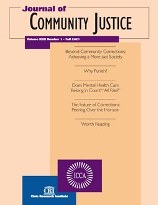The Appropriation of Rehabilitation Through the Logic of Risk
Author: Kimberley A. Clow.; Rosemary Ricciardelli.; Michael Adorjan.
Source: Volume 28, Number 04, Summer 2019 , pp.5-11(7)

< previous article |next article > |return to table of contents
Abstract:
Correctional Service Canada (CSC) strives to promote successful community reentry for formerly incarcerated individuals. Although always a contentious concept, “rehabilitation” remains a central construct during, and when preparing for, reintegration processes. Further, the threat a parolee is believed to pose to society and the “potential” for recidivism are derived from the ongoing assessment of both “static” and “dynamic” risk factors. This article analyzes the files of 164 male parolees in Canada to determine whether ratings of static or dynamic risk factors have greater predictive value in determining a parolee’s level of intervention upon release. The findings suggest that individuals in need of greater community functioning (e.g., needing to improve housing or financial security) are mandated to visit parole officers more than individuals needing improvement in other factors. Implications are discussed with reference to the surge in penal populism under the former Conservative Harper administration and to changes emerging under the Liberal Trudeau government elected in late 2015.Keywords: Parolees, reintegration, risk, need, Correctional Service Canada
Affiliations:
1: University of Ontario Institute of Technology; 2: Memorial University of Newfoundland; 3: University of Calgary.